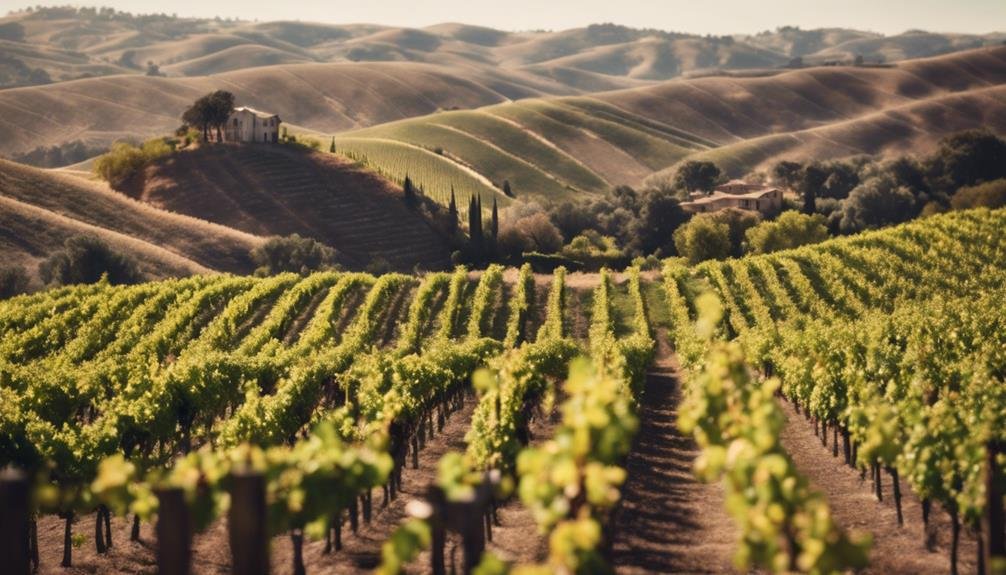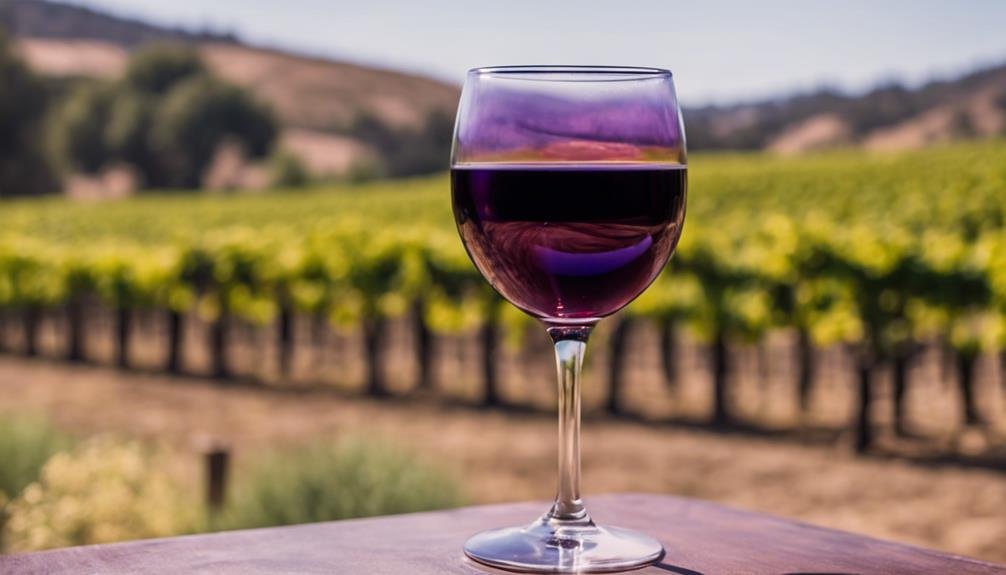Explore the diverse Zinfandel wine regions in California to uncover unique flavors shaped by terroir. Amador County offers jammy raspberry notes, while Lodi presents dark raspberry to mocha with a smokey maple finish. Napa Valley showcases aromatic blackberry and pepper hints, and Sonoma delivers softer, mocha flavors. Different soils and climates influence these distinct tastes across regions. Producers like Seghesio, Turley, and Outpost Winery stand out, with wines that pair beautifully with BBQ dishes and age gracefully, revealing complex layers. Discover more about these intricate Zinfandel styles and the heritage behind each bottle.
History of Zinfandel Wine
The historical evolution of Zinfandel wine traces back to its roots as a grape variety originating from Schönbrunn Palace in Vienna in the 1820s, eventually finding its way to California during the Gold Rush era of the 1850s.
Zinfandel, which is the same grape as the Croatian variety Crljenak Kaštelanski, has deep European connections. The journey of this grape variety from Europe to the United States showcases its rich history and cultural significance.
The transplantation of Zinfandel vines to California by the 49ers marked a pivotal moment in the development of the wine industry in the region. Understanding the Zinfandel grape origins and its European connections provides insight into the heritage and legacy of this beloved wine variety.
Characteristics of Zinfandel Varieties
The spectrum of Zinfandel varieties showcases an array of distinctive characteristics that contribute to its allure and complexity within the world of wine.
Zinfandel is known for its high acidity and spicy profile, with dominant berry flavors ranging from strawberry to blackberry. Oak-aged Zinfandels offer additional notes of 5-spice powder, cloves, and cinnamon. The alcohol levels in Zinfandel wines indicate richness, with riper grapes producing higher alcohol content.
When it comes to food pairings, Zinfandel pairs well with grilled meats, BBQ dishes, and aged cheeses. Regarding aging potential, some Zinfandel wines can age beautifully over 10-15 years, developing more complexity and depth.
Understanding these characteristics can help wine enthusiasts appreciate the diverse range of Zinfandel wines available.
Zinfandel Wine Regions in California

Amidst California's diverse wine landscape, the Zinfandel grape thrives in distinct regions, each imparting unique characteristics to the wines produced.
- Amador County: Known for producing jammy Zinfandels with raspberry and strawberry flavors.
- Lodi: Offers Zinfandels with dark raspberry to mocha flavors and a smokey maple finish.
- Napa Valley: Aromatic Zinfandels with blackberry and black pepper notes.
- Sonoma: Produces softer and more lush Zinfandels with mocha and 5-spice powder flavors.
These regions exhibit different soil compositions and climate influences, influencing the grape's growth and resulting wine profiles. By exploring these areas, wine enthusiasts can discover the diverse array of Zinfandel styles California has to offer.
Notable Producers of Zinfandel
Among the distinguished names in the world of Zinfandel, notable producers stand out for their exceptional wines and contributions to the varietal's legacy. Producers like Seghesio, Turley, and Outpost Winery have made a significant impact, offering Zinfandels known for their complexity and quality.
These wines often pair well with a variety of dishes, from BBQ ribs to hearty stews, showcasing the versatility of the varietal when it comes to food pairings. Additionally, the aging potential of Zinfandel wines from these producers is remarkable, with many showcasing the ability to develop beautifully over time, revealing layers of flavors and aromas that evolve with age.
For Zinfandel enthusiasts looking for wines with both immediate appeal and long-term aging potential, these producers are definitely worth exploring.
Exploring Unique Zinfandel Styles

Exploring the diverse array of Zinfandel styles offered by various regions in California reveals an intriguing tapestry of flavors and characteristics that captivate wine enthusiasts seeking unique tasting experiences.
- Comparing Flavor Profiles:
- Zinfandels from Amador County boast jammy raspberry and strawberry flavors, while Lodi Zinfandels offer dark raspberry to mocha notes with a smokey maple finish.
- Regional Influences:
- Napa Valley Zinfandels are aromatic with hints of blackberry and black pepper, whereas Sonoma Zinfandels are softer and more lush with flavors of mocha and 5-spice powder.
- Diversity in Styles:
- Paso Robles Zinfandels present floral characteristics with brambly raspberry flavors, while Zinfandels from Los Angeles/Riverside/Cucamonga showcase blackberry and tart black cherry profiles.
- Distinctive Characteristics:
- Each region's unique terroir and climate influence the grape's development, resulting in Zinfandels with distinct flavor profiles that reflect their origins.
Frequently Asked Questions
What Are the Best Food Pairings for Zinfandel Wines?
When considering food pairings for Zinfandel wines, explore options like spice-rubbed meats for spice pairings, aged cheeses for cheese pairings, chocolate desserts for dessert pairings, and grilled seafood for seafood pairings. These combinations enhance the wine's flavors.
How Does Zinfandel Compare to Other Popular Red Wine Varieties?
Zinfandel stands out among red wine varieties for its bold berry flavors, high acidity, and spicy notes. It offers a unique tasting experience, popular for its richness and diverse regional styles. Price points vary based on producer and region.
Are There Any Environmental Factors That Influence Zinfandel Flavors?
Soil composition and climate play significant roles in shaping Zinfandel flavors. Factors like grape maturity and fermentation techniques also impact the final taste profile. Understanding these environmental influences can enhance appreciation and selection of Zinfandel wines.
What Is the Ideal Temperature for Serving Zinfandel Wines?
The ideal temperature for serving Zinfandel wines is typically between 60-65 degrees Fahrenheit. This range allows the wine's flavors to fully express themselves without being overwhelmed by alcohol. Aging Zinfandels can enhance complexity and soften tannins.
Can Zinfandel Wines Benefit From Aging, and if So, for How Long?
Zinfandel wines can benefit from aging, enhancing flavor complexity over time. Ideal cellar storage minimizes oxidation risks. Generally, Zinfandels peak around 5-10 years, but some premium bottles can age well for 10-15 years, evolving elegantly.
Conclusion
To sum up, the diverse Zinfandel wine regions in California offer a rich tapestry of flavors and styles that reflect their unique terroirs.
One interesting statistic to note is that Lodi, known for its old-vine Zinfandel, boasts over 100 different grape varieties planted in its vineyards.
This level of diversity contributes to the complexity and allure of Zinfandel wines, making them a fascinating subject of exploration for wine enthusiasts.
